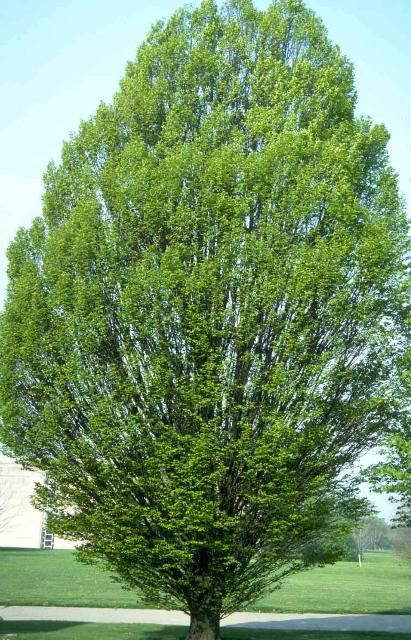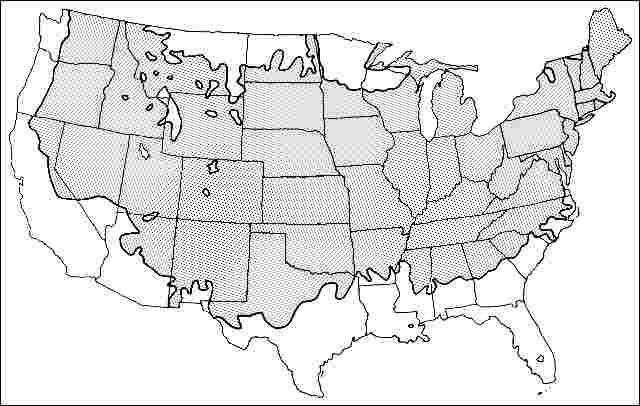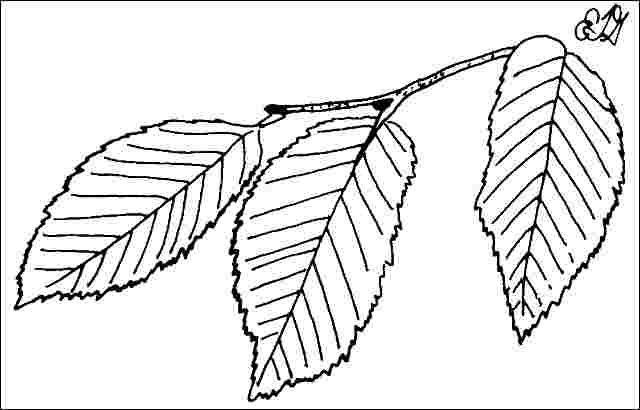Introduction
The species is not normally grown, but it reaches 60 feet tall and spreads 40 feet, preferring well-drained soil. Cultivars are more common than the species. The cultivar 'Fastigiata' is most often offered by nurseries and is a popular street tree. The species tolerates a pH above 7.0. The plant grows slowly, is shallow rooted, and can branch low to the ground. The crown is finely branched, densely foliated, and forms a beautiful oval or vase in the landscape. European hornbeam has yellow fall color and enough pruning tolerance to be a hedge, tall screen, or topiary. It was and is the plant of choice for clipped screens and hedges in English and early American gardens.

Credit: Ed Gilman
General Information
Scientific name: Carpinus betulus
Pronunciation: kar-PYE-nus BET-yoo-lus
Common name(s): European Hornbeam
Family: Betulaceae
USDA hardiness zones: 4A through 7B (Fig. 2)
Origin: not native to North America
Invasive potential: little invasive potential
Uses: specimen; hedge; screen; street without sidewalk; parking lot island < 100 sq. ft.; parking lot island 100–200 sq. ft.; parking lot island > 200 sq. ft.; sidewalk cutout (tree pit); tree lawn 3–4 feet wide; tree lawn 4–6 feet wide; tree lawn > 6 ft. wide; Bonsai; shade; highway median
Availability: not native to North America

Description
Height: 40 to 60 feet
Spread: 35 to 40 feet
Crown uniformity: symmetrical
Crown shape: oval, vase
Crown density: dense
Growth rate: slow
Texture: fine
Foliage
Leaf arrangement: alternate (Fig. 3)
Leaf type: simple
Leaf margin: double serrate
Leaf shape: ovate, oblong
Leaf venation: pinnate
Leaf type and persistence: deciduous
Leaf blade length: 2 to 4 inches
Leaf color: green
Fall color: yellow
Fall characteristic: showy

Flower
Flower color: white/cream/gray
Flower characteristics: not showy
Fruit
Fruit shape: oval
Fruit length: less than .5 inch
Fruit covering: dry or hard
Fruit color: brown
Fruit characteristics: attracts birds; not showy; fruit/leaves not a litter problem
Trunk and Branches
Trunk/bark/branches: branches droop; showy; can be trained to one trunk; thorns
Pruning requirement: little required
Breakage: resistant
Current year twig color: brown
Current year twig thickness: thin
Wood specific gravity: unknown
Culture
Light requirement: full sun, partial sun or partial shade, shade tolerant
Soil tolerances: clay; sand; loam; alkaline; acidic; well-drained; occasionally wet
Drought tolerance: high
Aerosol salt tolerance: none
Other
Roots: not a problem
Winter interest: yes
Outstanding tree: yes
Ozone sensitivity: tolerant
Verticillium wilt susceptibility: resistant
Pest resistance: resistant to pests/diseases
Use and Management
The tree lends itself well for use as a screen due to the densely foliated crown and low, dense branching. It can also be trained to one central leader and used as a fine street tree, but will benefit from occasional irrigation in a prolonged drought, although severe drought will not kill the tree but could cause die back. There are old plants in the South that look great, having received no irrigation in recent droughts. These plants were observed in areas where soil space was not limiting and roots were allowed to expand unhindered by urban structures like curbs, pavement, and sidewalks.
Lower branches should be removed early if using it for a street tree, but with lower branches intact it makes a wonderful climbing tree. The cultivars are usually very branchy and form a dense crown too thick to climb. The wood is very hard and strong and dulls woodworking tools quickly. Fruit and buds are eaten by many birds.
It is reportedly difficult to transplant, which, along with slow growth, probably accounts for its lack of use. Transplant from the field in the spring. But it has most of the attributes commonly associated with a good urban tree and should be planted more.
There are a number of useful cultivars of European hornbeam but they may be hard to find, except 'Fastigiata': 'Asplenifolia'—deeply lobed leaves; 'Columnaris'—narrow, dense growth habit, similar to and often confused with 'Fastigiata'; 'Fastigiata'—is generally available, 30 to 40 feet tall, dense, upright when young but spreading somewhat with age, can be used as an unpruned screen due to its resistance to wind, also very useful as a street tree, fine branches; 'Globosa'—rounded growth habit; 'Horizontalis'—flat topped; 'Incisa'—leaves deeply toothed, small leaves; 'Pendula'—weeping habit; 'Purpurea'—young leaves purplish; 'Pyramidalis'—upright.
Pests
Relatively few insects attack European hornbeam. Maple phenacoccus forms white cottony masses on the undersides of the leaves. Two-lined chestnut borer can cause dieback.
Diseases
None are normally very serious. Several fungi cause leaf spots on hornbeam. Leaf spots are not serious, so control measures are usually not needed.
Canker caused by several fungi causes infected branches to die back, and entire trees die if the trunk is infected and girdled. Severely infected trees cannot be saved, but infected branches are pruned out.
Powdery mildew causes a white powdery growth on the leaves. The disease is not common on Carpinus.